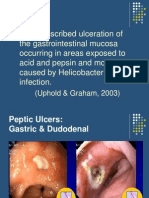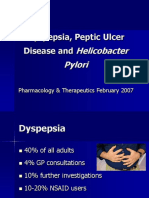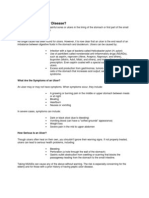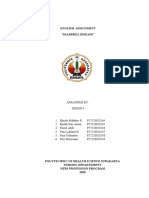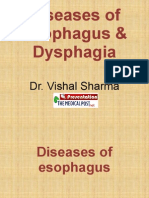0 ratings0% found this document useful (0 votes)
34 viewsCurrent Treatment of Dyspepsia: DR Wita Kartika Nurani SP - PD
Current Treatment of Dyspepsia: DR Wita Kartika Nurani SP - PD
Uploaded by
Aditya Rangga FandiartaThis document discusses the common causes, treatment approaches, and alarm signs for dyspepsia. It notes that the most common causes are reflux esophagitis, duodenal ulcers, and gastric ulcers. The first treatment approach is to consider causes outside the GI tract and stop any contributing medications. Patients exhibiting alarm symptoms like bleeding or weight loss should be referred immediately. All new dyspepsia patients should receive abdominal exams and blood tests. Those over 55 or with persistent or recent-onset dyspepsia without alarm signs may also be referred. Helicobacter pylori is a common cause that can be diagnosed via invasive or non-invasive tests and treated with a PPI and antibiotics regimen. Functional
Copyright:
© All Rights Reserved
Available Formats
Download as PPTX, PDF, TXT or read online from Scribd
Current Treatment of Dyspepsia: DR Wita Kartika Nurani SP - PD
Current Treatment of Dyspepsia: DR Wita Kartika Nurani SP - PD
Uploaded by
Aditya Rangga Fandiarta0 ratings0% found this document useful (0 votes)
34 views15 pagesThis document discusses the common causes, treatment approaches, and alarm signs for dyspepsia. It notes that the most common causes are reflux esophagitis, duodenal ulcers, and gastric ulcers. The first treatment approach is to consider causes outside the GI tract and stop any contributing medications. Patients exhibiting alarm symptoms like bleeding or weight loss should be referred immediately. All new dyspepsia patients should receive abdominal exams and blood tests. Those over 55 or with persistent or recent-onset dyspepsia without alarm signs may also be referred. Helicobacter pylori is a common cause that can be diagnosed via invasive or non-invasive tests and treated with a PPI and antibiotics regimen. Functional
Original Description:
teori dispepsia
Original Title
Dyspepsia
Copyright
© © All Rights Reserved
Available Formats
PPTX, PDF, TXT or read online from Scribd
Share this document
Did you find this document useful?
Is this content inappropriate?
This document discusses the common causes, treatment approaches, and alarm signs for dyspepsia. It notes that the most common causes are reflux esophagitis, duodenal ulcers, and gastric ulcers. The first treatment approach is to consider causes outside the GI tract and stop any contributing medications. Patients exhibiting alarm symptoms like bleeding or weight loss should be referred immediately. All new dyspepsia patients should receive abdominal exams and blood tests. Those over 55 or with persistent or recent-onset dyspepsia without alarm signs may also be referred. Helicobacter pylori is a common cause that can be diagnosed via invasive or non-invasive tests and treated with a PPI and antibiotics regimen. Functional
Copyright:
© All Rights Reserved
Available Formats
Download as PPTX, PDF, TXT or read online from Scribd
Download as pptx, pdf, or txt
0 ratings0% found this document useful (0 votes)
34 views15 pagesCurrent Treatment of Dyspepsia: DR Wita Kartika Nurani SP - PD
Current Treatment of Dyspepsia: DR Wita Kartika Nurani SP - PD
Uploaded by
Aditya Rangga FandiartaThis document discusses the common causes, treatment approaches, and alarm signs for dyspepsia. It notes that the most common causes are reflux esophagitis, duodenal ulcers, and gastric ulcers. The first treatment approach is to consider causes outside the GI tract and stop any contributing medications. Patients exhibiting alarm symptoms like bleeding or weight loss should be referred immediately. All new dyspepsia patients should receive abdominal exams and blood tests. Those over 55 or with persistent or recent-onset dyspepsia without alarm signs may also be referred. Helicobacter pylori is a common cause that can be diagnosed via invasive or non-invasive tests and treated with a PPI and antibiotics regimen. Functional
Copyright:
© All Rights Reserved
Available Formats
Download as PPTX, PDF, TXT or read online from Scribd
Download as pptx, pdf, or txt
You are on page 1of 15
Current Treatment of Dyspepsia
Dr Wita Kartika Nurani Sp.PD
Outline topics
Common causes of dyspepsia
First approach
Alarm signs
Referral
Helicobacter pylori
Functional Dyspepsia
Common Causes of Dyspepsia
Reflux oesophagitis 12%
Duodenal ulcer 10%
Gastric ulcer 6%
Gastric carcinoma 1%
Oesophageal carcinoma 0.5%
Non-erosive GORD
Functional (non-ulcer) dyspepsia
First Approach
1. Consider : possible causes outside upper GI tract
-Heart, lung, liver, gall bladder, pancreas, bowel
2. Consider drugs and stop if possible
- Aspirin / NSAIDs, calcium antagonists, nitrates,
theophyllines, etidronate, steroids
?
Alarm Symptoms/ Signs*
GI bleeding (same day referral)
Persistent vomiting
Weight loss (progressive unintentional)
Dysphagia
Epigastric mass
Anaemia due to possible GI blood loss
Thus all patients with new-onset dyspepsia should have
abdominal examination and FBC
Refer if dyspepsia in 55+* year old
With Alarm symptoms/signs
Without alarm symptom if :
Unexplained : no cause known
persistent : 4-6 weeks
recent-onset : new-not a recurrent episode
Helicobacter pylori
Gram negative bacteria
S-shaped, ~ 0.5 x 3 m
the genom of Hp encode
1500 proteins
Some of the proteins are
determinant of Hp
mediated pathogenesis &
colonization, such as :
Hop protein
Vac A
Cag-PAI
8
introduction
Medical community
couldnt believe a bacteria
could survive the acidity
Marshall drank a petri dish
of Hp, and 10 days later had
endoscopy where found
signs of gastritis and H
pylori.
estimated: 50% of the world
is affected
Developing nations:
prevalence of adults peaks
at more than 80% after age
20
2005: Marshall and Warren awarded
Nobel Prize in Medicine
9
Pathogenesis Hp
10
Diagnosing Hp :
-invasive
-non invasive
Invasive test : endoscopy :
Culture
Histology
Urease test
The preferred method of diagnosing Hp-by non invasive
method-in pre and post treatment setting are :
UBT
stool antigen test
One week triple therapy
PPI (full dose) e.g. Omeprazole 2x20mg
Clarithromycin 2x500mg
Amoxycillin 2x 1000 mg
FUNCTIONAL DYSPEPSIA
Treatment
Major challenge
Most agent : limitted/no evidence of efficacy
Testing for/eradicating Hp is a first line strategy irrespective of the
symptom pattern
MODALITIES OF TREATMENT
1.Epigastric pain
antisecretory agent are recommended
Antacids, bismuth, sucralfat --- no better than placebo
2.Postprandial fullness (early satiety)
prokinetics
Other treatment
-psychological tx : promising (confer benefits on both pain&meal related symptoms)
(Curr Treat opt Gastroenterol, 2007)
WITH
ALARM
NO
ALARM
> 55 yo
< 55 yo
1
month
Thank you
You might also like
- 379 Peterbuilt Heater-AcDocument2 pages379 Peterbuilt Heater-AcKeith Vest100% (4)
- 1613233502-InvestorPresentation-February2021 Fermenta BiotechDocument34 pages1613233502-InvestorPresentation-February2021 Fermenta Biotechravi.youNo ratings yet
- DuspatalinDocument8 pagesDuspatalinBilal Mashaqbeh0% (1)
- Approach To A Patient With DyspepsiaDocument35 pagesApproach To A Patient With DyspepsiaZahraa MurtadaNo ratings yet
- DyspepsiaDocument15 pagesDyspepsiaBo ChoiNo ratings yet
- Ulcer A 42008Document19 pagesUlcer A 42008postbasicNo ratings yet
- Gastroesophageal Reflux Disease: Scott Stolte, Pharm.D. Shenandoah UniversityDocument48 pagesGastroesophageal Reflux Disease: Scott Stolte, Pharm.D. Shenandoah UniversitymnmrznNo ratings yet
- Oleh: Fina Khairunnisa: Diagnosis and Treatment of Gastroesophageal Reflux DiseaseDocument14 pagesOleh: Fina Khairunnisa: Diagnosis and Treatment of Gastroesophageal Reflux DiseaseFina KhairunnisaNo ratings yet
- Heart BurnDocument6 pagesHeart BurnNader SmadiNo ratings yet
- DyspepsiaDocument7 pagesDyspepsiaLuvlie SomcioNo ratings yet
- Dyspepsia, Peptic Ulcer Disease And: Helicobacter PyloriDocument28 pagesDyspepsia, Peptic Ulcer Disease And: Helicobacter PyloriJohn GichunjiNo ratings yet
- DyspepsiaDocument28 pagesDyspepsiaKrairat Komdee100% (1)
- What Is Peptic Ulcer DiseaseDocument3 pagesWhat Is Peptic Ulcer DiseaseKarl Angelo SimbajonNo ratings yet
- Chapter 14. Intestinal GasDocument19 pagesChapter 14. Intestinal GasMonica CiorneiNo ratings yet
- GERD - PPT 11Document30 pagesGERD - PPT 11pharmaguy111No ratings yet
- Dyspepsia BrochureDocument5 pagesDyspepsia BrochureJns RamNo ratings yet
- Pharmacotherapy For GERDDocument6 pagesPharmacotherapy For GERDJoon HyungNo ratings yet
- Alcoholism Diet Obesity Diabetes: Fatty LiverDocument5 pagesAlcoholism Diet Obesity Diabetes: Fatty LiverMukul NehwalNo ratings yet
- Allergic Rhinitis - University of MichiganDocument12 pagesAllergic Rhinitis - University of MichiganarsyiadlinaNo ratings yet
- Nutrition BasicsDocument49 pagesNutrition Basicstoty-berryNo ratings yet
- Polmaforce RCPA Circular 16.10.23Document2 pagesPolmaforce RCPA Circular 16.10.23ALINo ratings yet
- Bombay Stock ExchangeDocument70 pagesBombay Stock ExchangeAnkit Misra100% (1)
- Maximize Your Productivity by Managing TasksDocument8 pagesMaximize Your Productivity by Managing TasksAnurag SharmaNo ratings yet
- Chapter 13. Heartburn and DyspepsiaDocument22 pagesChapter 13. Heartburn and DyspepsiaMonica CiorneiNo ratings yet
- Stock Market AnalysisDocument2 pagesStock Market AnalysisVijay DubeyNo ratings yet
- Atorvastatin Export Market AnalysisDocument19 pagesAtorvastatin Export Market AnalysisMr. Sunil KumarNo ratings yet
- How To Read Stock Market QuotesDocument13 pagesHow To Read Stock Market Quotesmark100% (1)
- Tiens Food Supplements CatalogueDocument26 pagesTiens Food Supplements CatalogueWahyu TriArya Budhi ChrissantyoNo ratings yet
- Niversity of The Philippines Manila: Nursing Health History Date of Interview: (Input) A. Biographic DataDocument4 pagesNiversity of The Philippines Manila: Nursing Health History Date of Interview: (Input) A. Biographic DataConstance Isabelle MercadoNo ratings yet
- Treatment of Liver and Spleen Illnesses by HerbsDocument16 pagesTreatment of Liver and Spleen Illnesses by HerbsZachary LeeNo ratings yet
- 36 ObesityDocument59 pages36 ObesitySheikNo ratings yet
- Vd. Rohini Rakesh Salve Associate Professor Department of Panchkarma Government Akhandanand Ayurved CollegeDocument35 pagesVd. Rohini Rakesh Salve Associate Professor Department of Panchkarma Government Akhandanand Ayurved CollegebrparekhNo ratings yet
- Best Price PCD Pharma CompaniesDocument11 pagesBest Price PCD Pharma Companiespcd Pharma FranchiseNo ratings yet
- Capital BudgetingDocument23 pagesCapital BudgetingSritejaMandalikaNo ratings yet
- Vitamins and MineralsDocument9 pagesVitamins and Mineralsnuradinman89No ratings yet
- Sheena Selwyn Sip ReportDocument37 pagesSheena Selwyn Sip ReportNikhil KharodeNo ratings yet
- Materi Narasumber 2 - Halal Pharmaceutical From The Perspectives of Industry (IAI Webinar) FINALDocument27 pagesMateri Narasumber 2 - Halal Pharmaceutical From The Perspectives of Industry (IAI Webinar) FINALTini SyamsuddinNo ratings yet
- Dyspepsia: Level of Competent: 4Document15 pagesDyspepsia: Level of Competent: 4Deff HaningNo ratings yet
- Co PP02032020Document12 pagesCo PP02032020Aashish SinghalNo ratings yet
- Concept of Agni - An Ayurvedic Review: Durgesh Gupta A.C. KarDocument5 pagesConcept of Agni - An Ayurvedic Review: Durgesh Gupta A.C. KarKumarNo ratings yet
- IBS ResearchDocument6 pagesIBS ResearchDrHassan Ahmed ShaikhNo ratings yet
- Wound ManagementDocument33 pagesWound Managementdr.yogaNo ratings yet
- Anti-Anginal DrugsDocument39 pagesAnti-Anginal Drugspoonam rana100% (1)
- Pharmacotherapy of Peptic Ulcer: DR ZareenDocument50 pagesPharmacotherapy of Peptic Ulcer: DR ZareenGareth BaleNo ratings yet
- Vegetarian DietsDocument5 pagesVegetarian DietsMariaaaNo ratings yet
- Book 1Document46 pagesBook 1Rohit GehiNo ratings yet
- Pharma API - CompaniesDocument9 pagesPharma API - Companiesadityamenon18No ratings yet
- Hyponidd Combination Rationale 2013 REV1Document26 pagesHyponidd Combination Rationale 2013 REV1Mitzi MitchellNo ratings yet
- DuphalacDocument6 pagesDuphalacOkky Sri PurwantiNo ratings yet
- Diet & GrahaniDocument6 pagesDiet & GrahaniSamhitha Ayurvedic ChennaiNo ratings yet
- Ayur TabletDocument11 pagesAyur TabletNarasannapeta Patanjali100% (1)
- Hit 6 PDFDocument2 pagesHit 6 PDFLeonor BrandaoNo ratings yet
- Management of Atisara (Diarrhoea) With Diet (Pathyapthya) From Ayurveda Perspective: A ReviewDocument7 pagesManagement of Atisara (Diarrhoea) With Diet (Pathyapthya) From Ayurveda Perspective: A ReviewsrijitavenkatNo ratings yet
- 1 PPT Liver CirrhosisDocument65 pages1 PPT Liver CirrhosisDannaMae CastroNo ratings yet
- English Diarrhea FixDocument20 pagesEnglish Diarrhea FixLa fazaNo ratings yet
- Evidence Based Ayurveda For Revitalization of Mental HealthDocument53 pagesEvidence Based Ayurveda For Revitalization of Mental HealthMatt AldridgeNo ratings yet
- List of Other Top 100 Ayurvedic Companies in IndiaDocument2 pagesList of Other Top 100 Ayurvedic Companies in Indiasocial.bhavikayurveda0% (1)
- Varunaa Shigru Guggulu and Bala Taila Matra Basti in The Management of Mootraghata (Benign Prostatic Hyperplasia) - A Pilot StudyDocument9 pagesVarunaa Shigru Guggulu and Bala Taila Matra Basti in The Management of Mootraghata (Benign Prostatic Hyperplasia) - A Pilot StudyDrPriyanka ChauhanNo ratings yet
- Agni in Ayurveda (Review Article)Document6 pagesAgni in Ayurveda (Review Article)Kumar KNo ratings yet
- 20 Diseases of Esophagus DysphagiaDocument146 pages20 Diseases of Esophagus Dysphagiaسعد الامبابى100% (1)
- Parts Information: Eaton Hydraulics DivisionDocument4 pagesParts Information: Eaton Hydraulics DivisionFernando SabinoNo ratings yet
- 2012 A Level Answers P1 and P2 Compiled FinalDocument12 pages2012 A Level Answers P1 and P2 Compiled FinalWesley TanNo ratings yet
- Blind To DetailsDocument6 pagesBlind To DetailsCarol TrầnNo ratings yet
- Ease of Doing Business PDFDocument3 pagesEase of Doing Business PDFDwight BlezaNo ratings yet
- Zetkama Fig. 275 SpecsDocument5 pagesZetkama Fig. 275 SpecsAntonio VelardeNo ratings yet
- A Coursebook on Aphasia and Other Neurogenic Language Disorders 5th Edition M.N. Hegde download pdfDocument67 pagesA Coursebook on Aphasia and Other Neurogenic Language Disorders 5th Edition M.N. Hegde download pdfjoharygoralNo ratings yet
- WARCO BILTRITE Rubber Products CatalogDocument39 pagesWARCO BILTRITE Rubber Products CatalogHuỳnh TGNo ratings yet
- Abdominal ParacentesisDocument4 pagesAbdominal ParacentesisAbu HassanNo ratings yet
- Atlas MetazoarioDocument71 pagesAtlas MetazoarioPaulo RobertoNo ratings yet
- Reading Sub-Test - Question Paper: Part CDocument10 pagesReading Sub-Test - Question Paper: Part CSarah Jane PetalioNo ratings yet
- CEGB Vol 3 TurbineDocument420 pagesCEGB Vol 3 Turbinesurendra7_14100% (9)
- Narrative Report On The Celebration of TeachersDocument7 pagesNarrative Report On The Celebration of TeachersROSE MAE PAWAYNo ratings yet
- A Semi-Detailed Lesson Plan in Industrial Arts I Davao Oriental State College of Science and Technology Prepared By: I. ObjectivesDocument8 pagesA Semi-Detailed Lesson Plan in Industrial Arts I Davao Oriental State College of Science and Technology Prepared By: I. ObjectivesJyra Mia CEMINENo ratings yet
- Grade 7 Economic and Management Sciences November ExamDocument10 pagesGrade 7 Economic and Management Sciences November ExamSindi SibandaNo ratings yet
- GCP CarbonBudget 2022 Slides v1.0Document94 pagesGCP CarbonBudget 2022 Slides v1.0rickyjamesNo ratings yet
- Consolidated CsDocument43 pagesConsolidated Cssarathindia22No ratings yet
- Butterfly ValveDocument57 pagesButterfly ValveQuoc Cuong PhanNo ratings yet
- Discharge Hose FH-40HC - Rv05Document1 pageDischarge Hose FH-40HC - Rv05Pablo Sanchez AmpueroNo ratings yet
- Brazilian Adaptation of The Hotel Task: A Tool For The Ecological Assessment of Executive FunctionsDocument9 pagesBrazilian Adaptation of The Hotel Task: A Tool For The Ecological Assessment of Executive FunctionsMarilia FrotaNo ratings yet
- 2006-11-10Document12 pages2006-11-10The University Daily KansanNo ratings yet
- Module in Teaching Competencies in AfaDocument401 pagesModule in Teaching Competencies in AfaJohnrey LatigayNo ratings yet
- EspDocument62 pagesEspGanesh Dasara100% (1)
- CBSE Class 9 Science Worksheet - Matter Around UsDocument2 pagesCBSE Class 9 Science Worksheet - Matter Around Usgayatri100% (1)
- Reflexes Check-List Possible Long-Term EffectsDocument6 pagesReflexes Check-List Possible Long-Term EffectsMartha Patricia López PimentelNo ratings yet
- M3000 Mobile POS Terminal. User Guide PDFDocument18 pagesM3000 Mobile POS Terminal. User Guide PDFProgramación VolátilNo ratings yet
- Medical Expense PILDocument2 pagesMedical Expense PILHansel FrancisNo ratings yet
- Pe11 Module 1 Stress ManagementDocument30 pagesPe11 Module 1 Stress ManagementFlordelyn CagadasNo ratings yet
- Khoj Working FileDocument32 pagesKhoj Working FileRajrishiNo ratings yet
- Proposal Indaac JabarDocument12 pagesProposal Indaac JabartiwiNo ratings yet





